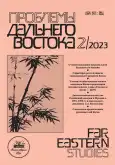Languages of “Modern” (Harbin Hotel “Modern” in the History of Russian-Chinese Cultural Relations)
- 作者: Khisamutdinov A.A.1, bai b.1
-
隶属关系:
- Far Eastern Federal University
- 期: 编号 2 (2023)
- 页面: 134-146
- 栏目: Articles
- URL: https://journals.rcsi.science/0131-2812/article/view/142495
- DOI: https://doi.org/10.31857/S013128120024928-1
- ID: 142495
全文:
详细
作者简介
Amir Khisamutdinov
Far Eastern Federal University
Email: pdvjournal@mail.ru
Vladivostok, Poletaev St., No. 49. 690041
baixue bai
Email: pdvjournal@mail.ru
参考
- Галкин М. Беседа с Ф.И. Шаляпиным в «Модерне» // Харбинское время. 1936. № 63 (8 марта). С. 12–14.
- ГАХК. ф. 830. Оп. 3. Д. 19702. Л. 27.
- Железнодорожная жизнь на Дальнем Востоке. 1914. 22 мая, № 19. С илл.
- Крадин Н.П. Русская Атлантида. Хабаровск: Издатель Хворов А.Ю., 2001. 352 с.
- Крадин Н.П. Русское архитектурное наследие в Харбине // Россия и АТР. 2003. С. 79–88.
- Левошко С.С. Русская архитектура в Маньчжурии. Конец XIX — первая половина XX века. Хабаровск: Частная коллекция, 2003.176 с.
- «Модерн» — живая душа старого Харбина (Амурский государственный университет). URL: https://www.youtube.com/watch?v=uCEj49dyaT4 (дата обращения: 28.06.2021).
- «На последнем перевале». Первая постановка Кружка самодеятельности при Гл. бюро // Рубеж. 1944. № 5 (10 февр.).
- Некролог С.А. Венсана // Заря. 1937. 27 июля, № 198. С. 2; Заря. 28 июля, № 199. С. 4; Харбинское время. 1937. 30 июля, № 201. С. 5.
- Полевые исследования авторов (Китай, апрель 2021).
- Театр «Модерн». Концерт А. Ловцовой // Рубеж. 1941. № 3 (11 янв.).
- Хисамутдинова Н.В. Из Владивостока — в эмиграцию: Судьбы дальневосточных профессоров // Вестник Кемеровского государственного университета. 2015. № 2–6 (62). С. 309–312.
- Цзюй Вэй и Цзюй Куньи. Наследие русской и китайской истории (Итоги международной выставки «Модерн»: Живая история старого Харбина». Харбин, 2017) // Россия и Китай на Дальневосточных рубежах: Сборник. Благовещенск, 2018. С. 125–131.
- Gamsa M. The many faces of Hotel Moderne in Harbin // East Asian History. 2011. № 37 (Dec.). Pp. 25–39.
- 哈尔滨公报 (Гун-Бао Харбин). 1919年11月13日.
- 哈尔滨公报 (Гун-Бао Харбин). 1927年2月19日.
- 哈尔滨公报 (Гун-Бао Харбин). 1932年10月3日.
- 哈尔滨公报 (Гун-Бао Харбин). 1933年3月1日.
- 刘连琨: 马迭尔九十年 (Лю Лянькун. Девяностолетний «Модерн»). 哈尔滨: 浩美彩色出版社, 1996年. 180页.
- 赵天: 哈尔滨饮食服务志 (Чжао Тянь. Записи пищевого обслуживания в Харбине). 哈尔滨: 黑龙江人民出版社, 1991年. 625页.
- 孙嘉驹: 马迭尔: 一座城市的缩影 (Сунь Цзяцзюй. Время цветения по-прежнему. «Модерн»: воплощение одного города). 哈尔滨: 哈尔滨出版社, 2019年. 194页.
- 王立勇: 中国商报: 哈尔滨品牌战略重塑老字号“第二春” (Ван Лиюн. Харбин перекраивает освященный временем бренд под символом «Вторая весна») // 品牌万里行. 30.06.2021. URL: http://brandpromotion.mofcom.gov.cn/article/b/bx/200610/20061003383297.shtml (дата обращения: 30.06.2021).









